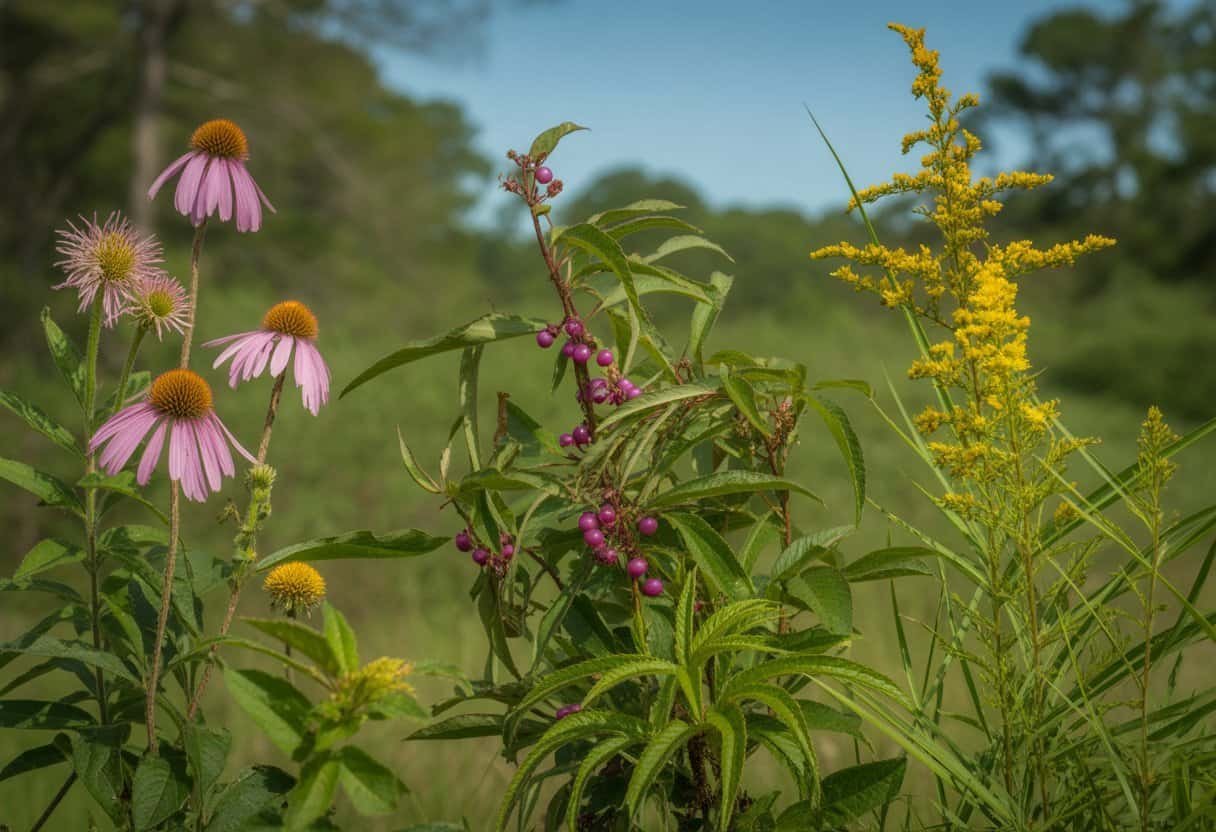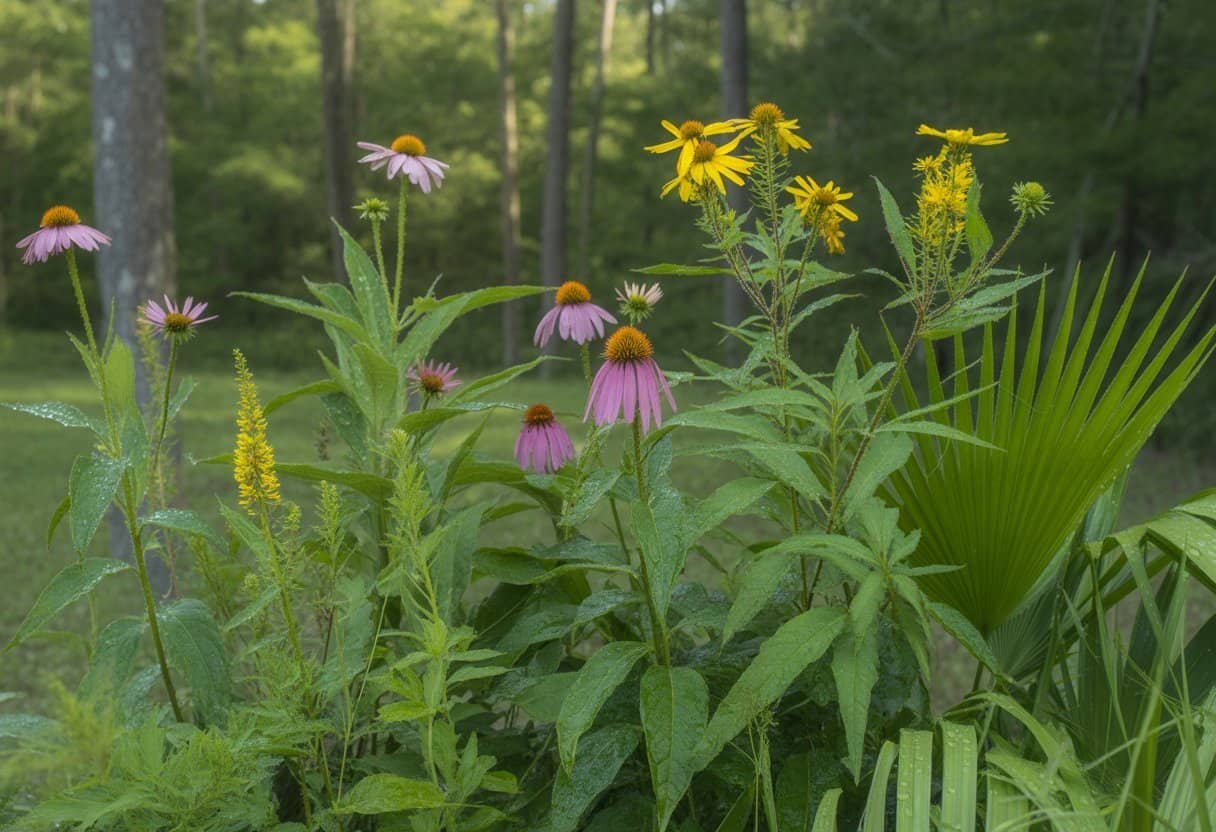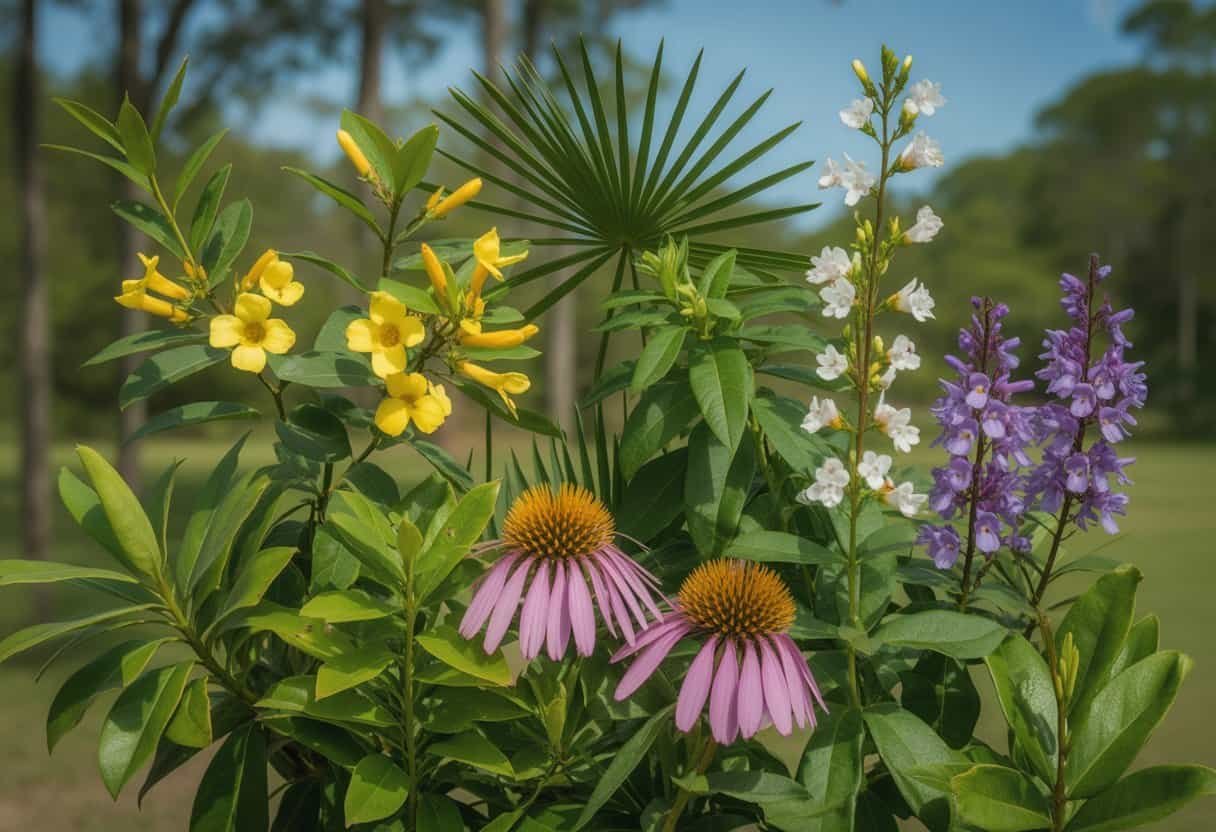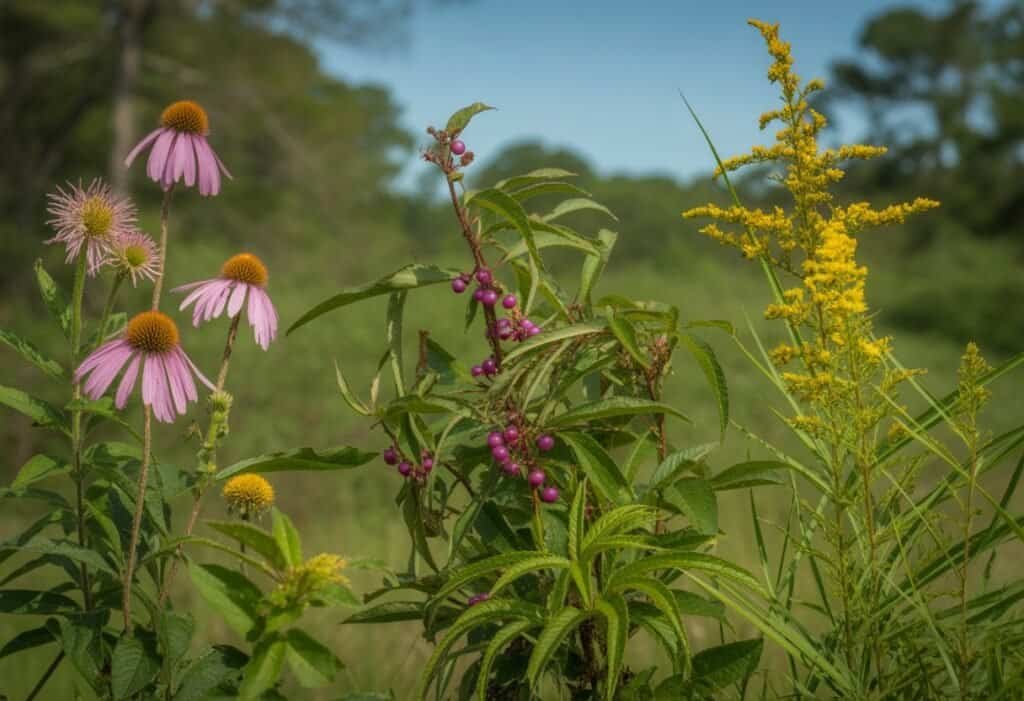South Carolina’s native plants offer beauty, resilience, and ecological benefits that non-native species cannot match. These plants have evolved over thousands of years to thrive in our unique climate and soil conditions.
Using native plants in your garden supports local wildlife while requiring less water, fertilizer, and maintenance than exotic alternatives.

From the coastal plains to the Blue Ridge Mountains, South Carolina boasts an impressive diversity of native flora. Plants like purple coneflower, Carolina jessamine, and oakleaf hydrangea showcase the state’s rich botanical heritage.
These natives have developed natural defenses against local pests and diseases.
Key Takeaways
- Native plants need less maintenance and fewer resources while providing essential habitat for local wildlife.
- South Carolina’s regions support different native plant communities adapted to specific soil and climate conditions.
- Incorporating natives into your landscape helps combat invasive species and preserves the state’s ecological balance.
What Makes a Plant Native to South Carolina?

Native plants in South Carolina evolved in the region over thousands of years. They adapted to local soil conditions, rainfall patterns, and seasonal changes.
These plants form the foundation of our state’s natural ecosystems. They provide essential habitat for wildlife.
Defining Native Species
Native plants are species that existed naturally in South Carolina before European settlement. These plants evolved alongside local wildlife, creating complex relationships over time.
The South Carolina Native Plant Society defines natives as plants that humans did not introduce, either accidentally or deliberately.
Native plants include trees like the Bald Cypress and Southern Magnolia. Shrubs such as Beautyberry and Witch Hazel, and wildflowers like Carolina Jessamine and Black-eyed Susan, are also native.
Scientists identify native plants through historical records, pollen samples from soil layers, and plant fossils. These methods help create accurate lists of plants that belong in South Carolina’s regions.
Benefits of Native Plants
Native plants need less maintenance once established because they have adapted to local conditions. They typically need less water, fertilizer, and pest control than non-native species.
These plants support local biodiversity by providing food and shelter for native wildlife. For example, native oak trees support over 500 species of caterpillars, while non-native trees support far fewer.
Wildlife Value of Native Plants:
- Food sources (berries, nectar, seeds)
- Nesting materials and shelter
- Host plants for butterfly and moth larvae
- Cover from predators
Native plants help prevent erosion, filter water, and improve soil health. Their deep roots help rainfall soak into the ground, reducing runoff and flooding.
Native Plant Communities
South Carolina hosts diverse native plant communities shaped by geography and climate. The state stretches from coastal marshes to mountain forests, creating unique plant groupings.
Major Native Plant Communities in South Carolina:
| Region | Characteristic Plants | Soil Type |
|---|---|---|
| Coastal | Sea Oats, Yaupon Holly | Sandy, saline |
| Piedmont | Oak-Hickory forests, Redbud | Clay, loam |
| Mountains | Rhododendron, Fraser Fir | Acidic, rocky |
These communities form complex ecosystems where plants, animals, fungi, and microorganisms interact. Each species plays a role in maintaining the health of the system.
Plant communities change gradually across the landscape based on soil, moisture, and elevation. This creates transition zones with mixed plant populations that add to South Carolina’s biodiversity.
Geographical Regions and Habitats of South Carolina
South Carolina features diverse geographical regions that support a wide variety of native plants. Each region offers unique soil conditions, elevations, and climate patterns that influence which plant species thrive.
Blue Ridge and Piedmont
The Blue Ridge region occupies the northwestern corner of South Carolina. Mountains in this area reach elevations of 3,500 feet.
This area experiences cooler temperatures and higher rainfall than other regions. Native trees like northern red oak, black birch, and eastern hemlock dominate these forests.
The understory features distinctive plants such as trillium, bloodroot, and wild ginger.
The Piedmont region stretches across the central part of the state. Rolling hills and clay-rich soils define this landscape.
Native Piedmont plants include oak-hickory forests with white oak, shagbark hickory, and flowering dogwood. Prairie-like areas feature native grasses such as little bluestem and indian grass, along with wildflowers like black-eyed Susan and butterfly weed.
Coastal Plain and Sandhills
The Coastal Plain covers nearly two-thirds of South Carolina. This flat, low-lying region has sandy, well-drained soils that support distinctive plant communities.
Longleaf pine savannas once dominated this region, featuring an open canopy with diverse understory plants. Wiregrass, pitcher plants, and sundews thrive in these sunny habitats.
The Sandhills form a narrow band between the Piedmont and Coastal Plain. Deep, infertile sandy soils create dry conditions despite abundant rainfall.
Turkey oak, longleaf pine, and scrub oak adapt well to these harsh conditions. The Sandhills also support rare plants like sandhill lily and pine barrens gentian that have evolved for nutrient-poor, dry soil.
Wetlands and Waterways
South Carolina’s wetlands include swamps, marshes, and bottomland forests. These habitats provide critical areas for specialized plants.
Cypress-tupelo swamps feature bald cypress and water tupelo trees with their distinctive “knees” rising from the water. These areas support understory plants like atamasco lily and spider lily.
Coastal salt marshes are dominated by smooth cordgrass and black needlerush. These salt-tolerant plants stabilize shorelines and provide essential wildlife habitat.
Carolina bays, mysterious elliptical depressions in the Coastal Plain, support rare plant communities. These isolated wetlands feature sundews, Venus flytraps, and pitcher plants that capture insects for nutrients in acidic environments.
Guide to Iconic South Carolina Native Plants

South Carolina’s diverse ecosystems support a wide variety of native plants that have adapted to the state’s climate and soils. These native species create habitat for local wildlife and require less maintenance than non-native alternatives.
Native Trees
South Carolina boasts impressive native trees that define the state’s landscape. The Southern Magnolia (Magnolia grandiflora) stands as an iconic symbol with glossy leaves and fragrant white flowers that bloom in summer.
The Bald Cypress (Taxodium distichum) thrives in wetland areas and is recognized by its “knees” that rise from the water. These trees can live for centuries.
Loblolly Pine (Pinus taeda) dominates many South Carolina forests. It grows quickly in various soil types and provides wildlife habitat and timber.
Eastern Hemlock (Tsuga canadensis) grows in the higher elevations of the state’s northwestern mountains. This evergreen faces threats from the invasive hemlock woolly adelgid.
Native Shrubs
Native shrubs provide food and shelter for wildlife and add beauty to landscapes. Carolina Jessamine (Gelsemium sempervirens), South Carolina’s state flower, produces fragrant yellow blooms in early spring.
Mountain Laurel (Kalmia latifolia) displays pink-white flowers in late spring. This evergreen shrub grows best in dappled shade and acidic soil.
Inkberry Holly (Ilex glabra) offers year-round interest with glossy evergreen leaves and black berries that persist through winter.
Oconee Azalea (Rhododendron flammeum) brings orange-red flowers to woodland edges in spring. This deciduous azalea is native to the Piedmont region.
Florida Anise (Illicium floridanum) features aromatic foliage and unusual star-shaped flowers. It grows well in moist, shaded locations.
Bottlebrush Buckeye (Aesculus parviflora) produces white flower spikes in summer that attract butterflies and hummingbirds.
Wildflowers and Herbaceous Perennials
South Carolina’s native wildflowers add color and ecological value to gardens. Purple Coneflower (Echinacea purpurea) attracts pollinators with purple petals and a raised center cone.
Wild Columbine (Aquilegia canadensis) features nodding red and yellow flowers in spring that appeal to hummingbirds. It grows well in light shade.
Wild Indigo (Baptisia species) produces spikes of blue, yellow, or white flowers followed by interesting seed pods. These drought-tolerant plants have deep roots that improve soil.
Beebalm (Monarda species) displays whorls of red, pink, or purple flowers that attract bees, butterflies, and hummingbirds. It has aromatic foliage.
Crested Iris (Iris cristata) forms colonies with lavender-blue flowers in spring. This small iris grows just 6-8 inches tall.
Aster species bloom in fall when many other flowers have faded. Their daisy-like flowers in purple, blue, or white provide late-season nectar for pollinators.
Grasses and Groundcovers
Native grasses and groundcovers serve important ecological functions. Sea Oats (Uniola paniculata) stabilize coastal dunes with their roots. Their seed heads add movement and texture to shoreline plantings.
Switchgrass (Panicum virgatum) adapts to many conditions from moist to dry. This grass provides food and shelter for birds and small mammals.
Pennsylvania Sedge (Carex pensylvanica) forms a low-growing alternative to traditional lawn grass in shady areas. It requires no mowing and tolerates dry conditions once established.
Green-and-gold (Chrysogonum virginianum) creates a semi-evergreen groundcover with yellow flowers from spring through fall. It spreads slowly to form neat colonies in partial shade.
Ecological Importance and Wildlife Value
South Carolina native plants form the backbone of local ecosystems. They provide essential food and shelter for wildlife and help maintain the region’s ecological balance.
These plants have evolved alongside local wildlife for thousands of years, creating interdependent relationships crucial for survival.
Biodiversity and Pollinator Support
Native plant communities support more biodiversity than areas with mostly non-native species. Research shows that native oak trees support over 500 species of caterpillars, while non-native ginkgo trees host only a few.
Caterpillars are a primary food source for songbirds. Creating a pollinator garden with native plants helps sustain local bees, butterflies, and other beneficial insects.
South Carolina favorites like purple coneflower, Joe-Pye weed, and goldenrod provide nectar throughout the growing season. Native plants need less maintenance once established because they have adapted to local rainfall and soil conditions.
Monarch Butterflies and Native Fauna
Monarch butterflies depend on milkweed plants (Asclepias species) to reproduce. The caterpillars eat only milkweed leaves, making these native plants critical for monarch survival.
South Carolina’s native milkweed varieties include:
- Butterfly weed (Asclepias tuberosa)
- Swamp milkweed (Asclepias incarnata)
- Common milkweed (Asclepias syriaca)
Native plants provide berries, seeds, and nuts that feed birds and mammals throughout the year. American beautyberry offers purple berries for birds in fall, while native oaks produce acorns for deer, squirrels, and turkey.
Many native plants also serve as host plants for specific insect species. These insects become food for larger animals, creating a healthy food web that supports diverse wildlife populations.
Soil, Climate, and Growing Conditions
South Carolina’s diverse environments create unique opportunities for native plants. Understanding these conditions helps gardeners choose the right plants and care for them properly.
Adapting to Local Climate
South Carolina has a humid subtropical climate with long, hot summers and mild winters. Average annual temperatures range from 50°F to 90°F, with USDA hardiness zones 7a to 9a.
Native plants have adapted to local weather, including heat waves and occasional cold snaps. Many species go dormant during extreme conditions.
Coastal areas face salt spray, strong winds, and hurricane threats. Mountain regions experience cooler temperatures and more frost days.
Climate change is extending growing seasons in South Carolina. Earlier spring blooms and later first frosts allow some native plants to expand their ranges.
Soil Types: Sandy, Clay, and More
South Carolina features diverse soil compositions:
Coastal Plain: Sandy, well-draining soils with limited nutrients
Midlands: Clay-loam mixtures with moderate fertility
Piedmont: Red clay soils, often compacted and slow-draining
Mountain region: Rocky, acidic soils rich in organic matter
Most native plants prefer acidic soils (pH 5.0-6.5). Test your soil to see if amendments are needed.
Clay soils benefit from added organic matter for better drainage. Mix compost into the top 6-8 inches to improve heavy clay.
Sandy soils drain quickly but lose nutrients. Adding compost helps retain moisture and nutrients.
Water and Irrigation Needs
Native plants usually need less watering than non-natives after they are established. Most require regular watering only during their first year.
Drought-tolerant natives like yucca, muhly grass, and coneflower may need extra water only during long dry spells.
For efficient irrigation, try these methods:
- Use drip systems to deliver water directly to roots
- Water in the morning to reduce evaporation
- Mulch to retain soil moisture
Water quality affects plant health. South Carolina’s water can contain high levels of minerals or chlorine. Rain barrels provide a good alternative for sensitive plants.
Group plants with similar water needs (hydrozoning) for efficient gardens. This practice helps prevent overwatering and underwatering.
Planting, Maintenance, and Sustainable Landscaping
Native South Carolina plants thrive with proper planting and sustainable care. The right techniques save water, reduce chemical use, and create beautiful landscapes that support local ecosystems.
Soil Preparation and Planting Techniques
South Carolina soils range from sandy coastal areas to clay-rich Piedmont regions. Test your soil before planting natives to check pH and nutrient levels. Most natives prefer slightly acidic soil (pH 5.5-6.5).
Prepare planting areas by removing weeds and loosening compacted soil to a depth of 12-18 inches. Add organic matter like compost to improve drainage or water retention as needed.
When planting, dig holes twice as wide as the root ball but only as deep. Set plants at the same depth as in their containers and water thoroughly after planting.
Plant in fall or early spring for best results. This timing allows roots to establish before summer heat.
Fertilizers and Pesticides
Native plants usually need little fertilizer after they are established. If needed, use slow-release organic fertilizers in early spring. Avoid high-nitrogen fertilizers that promote too much foliage growth.
Natural fertilizer options:
- Compost tea
- Fish emulsion
- Worm castings
- Leaf mold
Chemical pesticides harm beneficial insects that support native plant ecosystems. Use integrated pest management (IPM) instead. This includes hand-removing pests, introducing beneficial insects, and using organic deterrents.
Water plants at soil level to prevent fungal diseases. Space plants properly to improve air circulation and reduce disease risks.
Landscape Design for Commercial and Residential Spaces
Native plants create distinctive landscapes for both commercial properties and home gardens. Group plants with similar water and light needs for efficiency.
In residential gardens, use native shrubs to create “rooms.” Place taller plants at the back of borders and shorter ones in front. Select plants with different bloom times or berries for year-round interest.
Commercial landscapes benefit from drought-tolerant natives like muhly grass and black-eyed Susans for visual appeal with minimal care. Native trees such as sweetgum and bald cypress provide shade and help reduce cooling costs.
Rain gardens and bioswales pair well with natives and manage stormwater runoff. These features can replace parts of water-hungry lawns and create wildlife habitat.
Invasive Species and Threats to Native Flora
South Carolina’s native plant communities face major challenges from invasive species. These non-native plants often outcompete natives and can dramatically alter habitats.
Impacts of Non-Native Plants
Kudzu, Japanese honeysuckle, and Chinese privet are among South Carolina’s most destructive invasive plants. These species grow quickly and block sunlight from reaching native plants. English ivy climbs trees and can eventually kill them by adding weight and blocking light.
Invasive plants often share traits such as fast growth, prolific seed production, few natural predators, and efficient resource use.
The economic impact is significant. South Carolina spends millions each year to control invasive plants in parks, waterways, and forests. Lake Hartwell and other waterways struggle with hydrilla and water hyacinth, which clog boat motors and disrupt aquatic ecosystems.
Preservation and Restoration Efforts
The South Carolina Native Plant Society leads efforts to combat invasive species. Volunteer removal programs target heavily affected areas, especially in state parks and protected lands.
Best practices for homeowners include:
- Removing invasive plants from gardens
- Choosing native alternatives for landscaping
- Disposing of yard waste properly to prevent spread
- Reporting new invasive populations to authorities
Several restoration projects have made progress. At Congaree National Park, removing Chinese tallow trees has helped protect the floodplain ecosystem. Native plant nurseries in the state supply indigenous species for these projects.
Education remains important. The Clemson Extension Service offers workshops on identifying invasive plants and proper removal. These programs help citizens protect South Carolina’s botanical heritage.
Frequently Asked Questions
South Carolina has a rich variety of native plants that thrive in local conditions. These species support wildlife and generally need less maintenance than non-natives.
What are some common native plants found in South Carolina landscapes?
Carolina jessamine brightens gardens with vibrant yellow flowers. This climbing vine is the state flower and blooms from February to March.
Oakleaf hydrangea grows in woodlands and produces white flower clusters that turn pink as they age. Its leaves turn burgundy in fall.
Eastern redbud trees display pink-purple blooms in early spring before their heart-shaped leaves appear. These small trees reach 20-30 feet and adapt to various soils.
Butterfly weed attracts monarch butterflies with bright orange flowers. This perennial thrives in sunny, well-drained spots.
How can you identify native plants in South Carolina?
Leaf arrangement helps with plant identification. Check if leaves grow opposite or alternate along stems.
Native plant guidebooks for South Carolina assist with identification. The South Carolina Native Plant Society offers field guides with photos and descriptions.
Plant identification apps like iNaturalist let users take photos for instant ID suggestions. These tools often include native status and growing details.
Flower color, shape, and blooming season also help distinguish species. Native plant nurseries usually label their plants clearly.
What native shrubs are best suited for home landscaping in South Carolina?
American beautyberry produces clusters of purple berries that last through fall. This shrub grows 3-5 feet tall and prefers partial shade.
Inkberry holly offers evergreen foliage and black berries for birds. This shrub works well in foundation plantings or hedges.
Sweet pepperbush (Clethra alnifolia) has fragrant white flower spikes in summer. It grows 3-8 feet tall and attracts many pollinators.
Virginia sweetspire features arching branches with fragrant white flowers in spring. Its foliage turns red in fall, adding seasonal color.
Which native plants are recommended for gardening in the upstate region of South Carolina?
Black-eyed Susan thrives in the upstate’s clay soils and full sun. These golden flowers bloom from June through September and self-seed easily.
Wild ginger makes a great groundcover for shady gardens. Its heart-shaped leaves form a dense carpet that helps prevent erosion.
Foamflower produces delicate white blooms above attractive foliage. This native prefers cool, shady upstate forests.
Christmas fern stays green through winter in upstate gardens. This tough fern adapts to rocky, shaded slopes.
What indigenous South Carolina plants are known for their resilience and low maintenance?
Yaupon holly tolerates drought, poor soil, and coastal conditions. This evergreen can be pruned into a hedge or left to grow naturally.
Little bluestem grass needs minimal care once established. Its copper-colored foliage and fluffy seed heads add winter interest.
Purple coneflower blooms through summer heat and drought. Its deep roots help it survive tough conditions and provide seeds for goldfinches.
Adam’s needle yucca thrives in poor soil and full sun. Its white flower stalks rise above spiky foliage, adding architectural interest.
Which native flowers of South Carolina are most beneficial for local wildlife?
Joe-Pye weed attracts many butterfly species with its large pink flower clusters. This tall perennial blooms in late summer.
Swamp milkweed offers essential habitat for monarch butterfly caterpillars. Its pink flowers attract adult butterflies and other pollinators.
Blazing star grows purple flower spikes that draw hummingbirds and butterflies. These blooms appear in late summer and provide seeds for birds in fall.
New England aster gives late-season nectar to migrating butterflies. Its purple flowers bloom from August through October when food sources are scarce.


